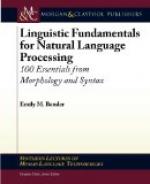On the other hand, there are many instances where the single declaration of a fact may convey to the untutored mind, a single thought or nearly so, when the better cultivated will take into the account the whole process by which it is effected. To illustrate: a man killed a deer. Here the boy would see and imagine more than he is yet fully able to comprehend. He will see the obvious fact that the man levels his musket, the gun goes off with a loud report, and the deer falls and dies. How this is all produced he does not understand, but knowing the fact he asserts the single truth—the man killed the deer. As the child advances, he will learn that the sentence conveys to the mind more than he at first perceived. He now understands how it was accomplished. The man had a gun. Then he must go back to the gunsmith and see how it was made, thence back to the iron taken from its bed, and wrought into bars; all the processes by which it is brought into the shape of a gun, the tools and machinery employed; the wood for the stock, its quality and production; the size, form and color of the lock, the principle upon which it moves; the flint, the effect produced by a collision with the steel, or a percussion cap, and its composition; till he finds a single gun in the hands of a man. The man is present with this gun. The motives which brought him here; the movements of his limbs, regulated by the determinations of the mind, and a thousand other such thoughts, might be taken into the account. Then the deer, his size, form, color, manner of living, next may claim a passing thought. But I need not enlarge. Here they both stand. The man has just seen the deer. As quick as thought his eye passes over the ground, sees the prey is within proper distance, takes aim, pulls the trigger, that loosens a spring, which forces the flint against the steel; this produces a spark, which ignites the charcoal, and the sulphur and nitre combined, explode and force the wad, which forces the ball from the gun, and is borne thro the air till it reaches the deer, enters his body by displacing the skin and flesh, deranges the animal functions, and death ensues. The whole and much more is expressed in the single phrase, “a man killed a deer.”
It would be needless for me to stop here, and examine all the operations of the mind in coming at this state of knowledge. That is not the object of the present work. Such a duty belongs to another treatise, which may some day be undertaken, on logic and the science of the mind. The hint here given will enable you to perceive how the mind expands, and how language keeps pace with every advancing step, and, also, how combinations are made from simple things, as a house is made of timber, boards, shingles, nails, and paints; or of bricks, stone, and mortar; as the case may be, and when completed, a single term may express the idea, and you speak of a wood, or a brick house. Following this suggestion, by tracing




